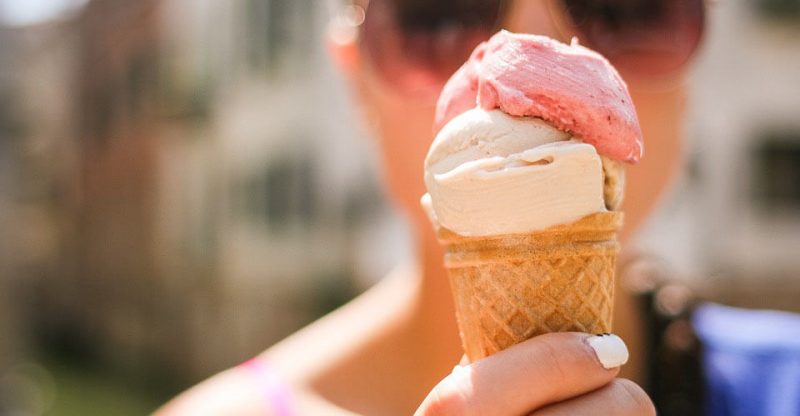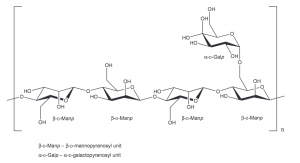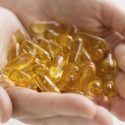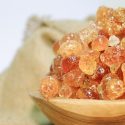What is Locust Bean Gum (E410) in Food: Uses, Safety, Side effects

What is it | Property | Uses | Safety | Health benefits | Side effects | FAQs
Locust bean gum, or carob bean gum, also referred to its abbreviation – LBG. It is a natural food additive derived from the endosperm of the seed of the carob (locust) tree, commonly used as a thickener, stabilizer and gelling agent in food with the European food additive number E410. Generally, it is vegan and gluten free.
What is Locust Bean Gum?
Definition
According to the FDA’s definition, it is primarily the macerated endosperm of the seed of the locust (carob) bean tree, with lesser quantities of seed coat and germ. (1)
Structure
As galactomannans take a large part of LBG, so LBG may be chemically described as galactomannan, similar to tara gum and guar gum.
The chemical structure of galactomannans is composed of linear chains of (1-4) linked beta-D mannose residues and the side chain of (1-6) linked alpha-D galactose.

Image Source
What is Locust Bean Gum Made of?
LBG is composed of galactomannans (not less than 75% in specification by EU) by the unit of mannose and galactose approximately in a ratio of 4:1.
This ratio is 3:1 in tara gum and 2:1 in guar gum.
The remaining consists mainly of protein and fibrous matter such as residues from the germ, seed coat and cell wall material.
How is Locust Bean Gum Made?
Generally, there are two methods to produce LBG, using acid process or roasting process.
- Acid process: firstly, the carob fruit pods are kibbled to obtain the seed from the pulp. Then the seeds are heated with sulfuric acid to remove the seed coat, separate germs and get endosperm.
- Roasting process: the seeds are treated with thermal mechanical method, roasted in a rotating furnace to remove the seed coat and obtain germ and the endosperm.
Two Types of Locust Bean Gum
LBG can be divided into two types, standard LBG and refined (clarified) LBG, depending on whether further manufacturing process is done or not to remove cellulose components.
The latter (doesn’t contain cellulose components) is clarified by dispersing in hot water, filtration and precipitation with ethanol or isopropanol, filtering, drying and milling.
Specification
Appearance
White to yellowish-white, nearly odourless powder.
| Other names |
|
| CAS number | 9000-40-2 |
| Chemical formula | NA |
| Molecular weight | 50,000 -3,000,000 |
Properties
Solubility
In cold water
LBG can be swelled and dispersed in cold and hot water to form a colloidal solution. It is converted into a gel if a small amount of sodium tetraborate is added. The dispersion is partially dissolved in water at ambient temperature.
In hot water
It is completely dissolved in hot water above 85 degrees Celsius for 10 minutes and becomes a viscous liquid. (2)
Inherent factors that influences Solubility
LBG or galactomannans become more soluble in water when the degree of galactose substitution on mannose chain increases.
Solutions are cloudy with a white opacity due to the presence of insoluble impurities such as proteins and cellulose.
The solubility varies with the molecular weight, it declines with increasing molecular weight and increasing concentration.
In organic solvent
Insoluble in most organic solvents including ethanol.
Viscosity
- Highly viscous at low concentration: the viscosity can reach to 2,000 to 6,000 mPa.s at 1% solution.
- PH tolerance: LBG is a nonionic, neutral vegetable gum, the viscosity is little affected by ionic strength and pH ranges from 3 to 11.
Synergy
Locust bean gum exhibits synergistic effects with other hydrocolloids like kappa carrageenan, agar and xanthan gum. That’s to say, it will react with these gums, result in
- increasing the viscosity
- increased gelling for desserts, cream cheeses and pet foods
- providing elasticity to the gel and reducing syneresis
Gelling agent
Generally, locust bean gum is not a gelling agent under normal conditions.
However, if a high concentration of its solution, for example, a 3% solution has sufficient viscosity to have the appearance of gelling.
And gels can be obtained through freeze-thaw treatment or with borate (pH≥7) or of a large amount of saccharose.
What’re the Application of Locust Bean Gum?
Generally, its uses in food, feed, cosmetics and pharmaceutical are for its thickening and stabilizing properties.
Food
Commonly we can find the following food with it: ice cream, yogurt, cheese, beverages, sauce & dressing, bakery and pet foods. The most common addition is between 0.2% and 0.5%.
Ice cream
The stabilizing and water-binding characteristics making it an ideal ingredient in frozen dairy applications, such as in ice cream to create a creamy texture, as well as inhibit the formation of ice crystals.
Yogurt
LBG helps thicken the yogurt and gives it a good mouthfeel.
Jellies
It creates transparent jellies and preventing syneresis.
Cheese
The strong synergies with other hydrocolloids and the binding water properties giving locust bean gum speed coagulation and increase the yield of curd solids in soft cheese manufacturing.
Beverage
LBG provides transparent solutions and maintains turbidity in soft drinks and juices.
Sauces and dressings
Synergistic interactions with xanthan gum or agar to improve viscosity and texture.
Bakery
LBG can make the baking products have a better texture, softer and prolong the shelf life for its water-holding properties.
Source of fiber
It can be used as a source of soluble fiber in food supplements and dietetic products.
Pet food
Providing viscosity and be synergistic with carrageenan and xanthan gum to create elastic gels such as in cat and dog food.
Cosmetics
Per “European Commission database for information on cosmetic substances and ingredients”, LBG can work as a binding, emollient, emulsion stabilising, film forming, masking and viscosity controlling agent in cosmetic and personal care products. (3)
Is Locust Bean Gum Safe to eat?
Yes, its safety as a food additive has been approved by the U.S. Food and Drug Administration (FDA), European Food Safety Authority (EFSA), Joint FAO/WHO Expert Committee on Food Additives (JECFA), as well as other authorities.
FDA
Locust bean gum is generally recognized as safe (GRAS) and can be used as an emulsifier or emulsifier salt, flavor enhancer, flavoring agent or adjuvant, solvent or vehicle, stabilizer or thickener, and texturizer in food. (4)
The following food may contain it and the max uses level (5):
- Cheeses: 0.80%
- Gelatins, puddings, and fillings: 0.75%
- Jams and jellies: 0.75%
- Beverages and beverage bases: 0.25%
- Baked goods and baking mixes: 0.15%
- All other food categories: 0.50%
EFSA
Locust bean gum (E 410) is authorised as a food additive in the EU according to Annexes II and III to Regulation (EC) No 1333/20083 and categorized as “additives other than colours and sweeteners” (6)
Safety re-evaluation in 2016
After the study on genotoxicity, carcinogenicity, reproductive and developmental toxicity, EFSA concluded that “there is no need for a numerical ADI for locust bean gum (E 410), and that there is no safety concern for the general population at the refined exposure assessment for its reported uses as a food additive.
However, infants and young children consuming foods for special medical purposes may show a higher susceptibility to gastrointestinal effects of locust bean gum due to their underlying medical condition ” (7)
Uses
Its approved application is listed in Group I and separately by E410. The uses in almost all authorised food categories are quantum satis (QS).
Following foods may contain it (8):
- Table-top sweeteners
- Foods for infants and young children
- Jam, jellies and marmalades and sweetened chestnut purée
- Fruit or vegetable spreads
- Canned or bottled fruit and vegetables
UK Food Standards Agency
Categorized in an emulsifier, stabiliser, thickener and gelling agent. (9)
Food Standards Australia New Zealand
It is an approved ingredient in Australia and New Zealand with the code number 410. (10)
JECFA
Function Class: food additives, emulsifier, stabilizer, thickener. (11)
Acceptable daily intake (ADI): ADI “not specified” set since 1981, the conclusion that “available studies are not sufficient for the evaluation of its use in infant formula at the proposed use level” was made in 2016. (12)
What are the Health Benefits?
Carob bean gum is a naturally occurring fiber meeting the FDA’s definition of dietary fiber which has the following health benefits to our body. (13):
- Lowering blood glucose/blood pressure
- Decreasing cholesterol levels
- Improving bowel movements (improved laxation)
- Reducing energy intake
FDA also put these ingredients in the approved list of dietary fibers:
What are the Possible Side Effects?
It is common that sometimes consumers have questions whether LBG is bad for our health and what are the side effects. We understand that consumers have concerns about ingredients in the foods we eat. There were few side effects reported but may with allergy symptoms.
Allergy
Allergic sinusitis and severe asthma were caused in a cheesemaker whose work can touch with LBG every day, which was reported by the American Journal Of Industrial Medicine in 2017. (14)
As EFSA pointed out, hypersensitivity and undesirable gastrointestinal effects, such as diarrhea, frequent loose stools and flatulence occurred when locust bean gum was used to treat gastro-oesophageal reflux (GOR) in infants and young children.
Is it Safe For Pregnant?
Yes, it is generally safe, but consult with your doctor.
Frequently asked questions
Is it Natural?
Yes, as mentioned above we can know it naturally comes from carob tree seeds.
Is it Halal?
Yes, it is generally recognised as halal and we can find several manufacturers certificated with MUI halal.
Is it Kosher?
Yes, it is kosher pareve. LBG has met all the “kashruth” requirements and can be certified as kosher.
Is it Gluten free?
Yes, carob bean gum is gluten free according to the FDA’s definition as LBG does not contain wheat, rye, barley, or crossbreeds of these grains. (15)
Is it Vegan?
Yes, it is vegan as it is plant-based which is sourced from the carob tree seeds and the manufacturing process without the use of animal matter or products derived from animal origin. So it is appropriate for vegetarian diets.
Conclusion
Locust bean gum is a natural, plant-based thickening agent that can be found in many food products with its name or E410.
Its application may become more popular as it is an authorized dietary fiber by FDA which is good for our body, especially for the commercial products which are intended to help people lower blood sugar & pressure and control cholesterol levels.
What do you think of this ingredient? Let me know in the comments.


